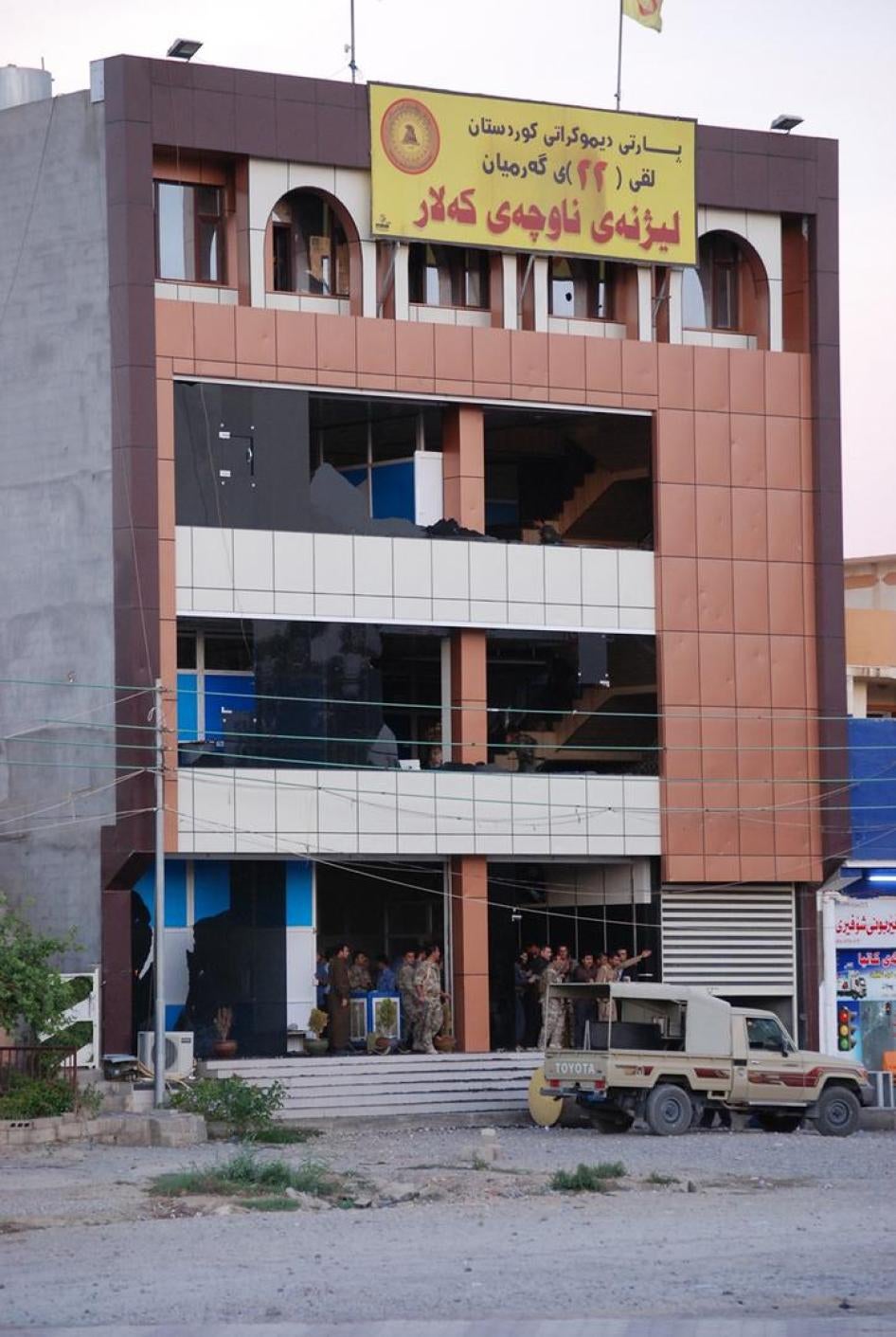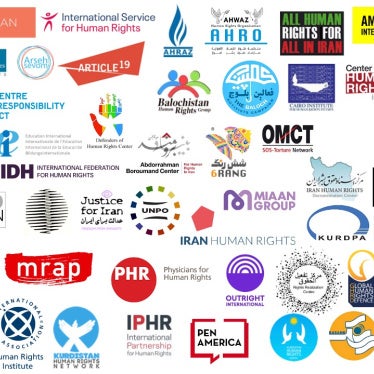(Beirut) – Ruling party forces opened fire on protesters in two cities of Iraqi Kurdistan on October 9 and 10, 2015. In the days since, security forces controlled by the ruling Kurdistan Democratic Party (KDP) have shut down opposition media and barred opposition party members of parliament from their offices.
Thousands of protesters had gathered in several towns and cities across Sulaimaniya governorate to demand jobs, payment of back wages, and the resignation of Masoud Barzani, president of the Kurdish Regional Government (KRG) and head of the KDP. Two protesters and a third man died in the town of Fort Diza (Qala Diza or “Du ze”, “between two rivers”) on October 9, and two others, both reported to have been unarmed, died in the town of Kalar on October 10.
“Kurdish authorities should, as a matter of priority, get to the bottom of why five people are dead,” said Joe Stork, deputy Middle East director. “The authorities should open a credible and independent investigation to find out who was responsible and whether the use of lethal force was justified, and if not, hold those responsible accountable.”
In Kalar, northeast of Baghdad, on October 10, hundreds of stone-throwing demonstrators surrounded on three sides a tall office building housing the offices of the ruling party. Armed men opened fire from inside the building, killing Uthman Adnan Muhammad, 19, and Araz Bayez, 35. Both were unarmed and stood a few hundred meters away from the building, Araz Muhammad, a local journalist who stood close by, told Human Rights Watch.
Although the circumstances suggest that the gunfire from the KDP building was the cause, party officials have blamed demonstrators. Muhammad said he did not see demonstrators carrying firearms.
On October 9, in Fort Diza, 260 kilometers north of Kalar, people in ruling party offices opened fire at demonstrators who were throwing stones and carrying AK-47 rifles, killing Muhammad Rasul, in his late teens or early twenties, and Muhammad Abdullah, in his late twenties, a Fort Diza resident who said he witnessed the shootings told Human Rights Watch.
The United Nations Basic Principles on the Use of Force and Firearms require that, “intentional lethal use of firearms may only be made when strictly unavoidable in order to protect life.”
On October 10, a fifth protester, Diyar Khidir Rasul, who was in his early teens, died in Raparin, near Fort Diza, when protesters set the KDP offices there on fire. Rasul was inside and apparently unable to escape, said Wirya Fatah, a resident who was on the scene.
Following the protests, the governing party moved to oust members of the opposition Gorran (Change) movement. On October 12, security forces prevented Muhammad Yusif Sadiq, a Gorran member and speaker of the regional parliament, from entering the Erbil governorate, where the parliament is located, three Kurdish activists told Human Rights Watch. On October 11, security forces had barred the four regional government ministers from Gorran from their offices. Prime Minister Nechirvan Barzan, on October 12, asked the Gorran ministers to resign.
On October 10, government security forces entered the offices of the independent NRT satellite television station in Erbil and detained staff, Ramen Gareb, director of Metro Center for Journalists’ Rights and Advocacy in Sulaimaniya, told Human Rights Watch. He said he has been in communication with the detained journalists.
He said the journalists were taken to Sulaimaniya governorate and ordered not to return to Erbil. On October 13, governing party officials allowed the NRT staff to return to Erbil and reopen their offices, the channel reported.
Also on October 10, security forces arrived at the offices of the Kurdish News Network (KNN), a satellite television channel associated with Gorran, and forcibly moved staff to Sulaimaniya province. They have not been allowed to return.
“The KDP claims to be rights-respecting but has a history of shutting down critical voices,” Stork said. “Barring elected members of parliament from doing their job and forcing critical media staff out of the governorate is a new low.”
Details of the Shootings
Kalar
Several hundred people gathered on October 10 to protest lack of jobs and payment of salaries for government employees, and against President Barzani, Muhammad, a local photojournalist covering the demonstration, told Human Rights Watch. Protesters sporadically threw rocks, he said, and around 6 p.m. they began pelting the offices of KDP branch number 22, shattering windows. KDP office guards responded with occasional warning shots into the air.
Around 6.30 p.m., two large pickup trucks drove through the crowd in an attempt to scatter protesters. Muhammad estimated that about 35 men, some in traditional Kurdish clothes and others in security uniforms, got out of the vehicles in front of the KDP office. About 20 of the men were armed and fired warning shots, into the air and then into the ground, in front of the protesters. The shooters then retreated to the top floor of the KDP offices and fired toward the crowd from there, Muhammad said.
He said he was standing four meters behind Uthman Adnan Muhammad and Bayez when they were fatally wounded around 6:30 p.m. by bullets fired from the direction of the KDP offices. He said that neither Uthman Muhammad nor Bayez had been throwing rocks and that they were standing several hundred meters from the KDP offices. He also said that all shots he heard came from the direction of the KDP offices.
Although protesters had surrounded three sides of the KDP offices, anyone inside could have left through the rear exit, which was not blocked, he said.
On October 10, Hemin Hawarami, head of the KDP foreign relations office, claimed that Gorran protesters had killed Muhammed, who was a KDP member and had relatives inside the KDP building. Najat Hassan, a KDP official responsible for Fort Diza and other districts, also laid the blame for the violence at the hands of the protesters, telling al-Sharq al-Awsat newspaper that demonstrators had shot at KDP security guards. He claimed that Gorran was behind the protester violence.
Fort Diza
A Fort Diza resident, Ali Qadir, told Human Rights Watch that at around 2 p.m. on October 9, small numbers of local youth demonstrated for jobs and President Barzani’s resignation. Qadir said he learned this from phone calls from friends in town. Over the course of the afternoon, he said, more people joined and marched to the city government offices, where Mayor Bakir Bayez, a Gorran member, tried to speak with them. Protesters pelted Bayez and his guards with stones, Qadir’s friends said, and around 5:30 p.m. marched on toward the KDP offices in the town center, which they also attacked with stones. Qadir had by then gone to the scene.
Around 6 p.m., Qadir said, he tried to grab a one-armed man shooting at the ground in front of demonstrators from just outside the KDP office, but stopped when the man turned his rifle toward Qadir. Then, Qadir said, several armed men, some in civilian clothes and some in military uniforms, went inside the KDP office and to the top floor and onto the roof, and fired bursts of live ammunition at demonstrators. Qadir said he saw six people wounded by gunshots fired from the direction of the office, one with a head wound. He said he saw about 10 demonstrators carrying AK 47 assault rifles, but they did not fire them.
Qadir said he then saw a delegation of Mayor Bayez, a security official from nearby Raparin, and the local member of Kurdistan’s parliament enter the KDP offices with their bodyguards. Shortly thereafter, another burst of automatic gunfire erupted from the roof, wounding two people no more than 20 meters from Qadir. Later that evening, when demonstrators got closer to the KDP building chanting anti-KDP slogans, Qadir said, he heard a short burst of heavier machine gun fire from inside the KDP offices. Very shortly thereafter, he saw demonstrators carry away a man about 30 years old, with a large part of the back of his head missing. Local security forces then led the KDP officials out of the building and demonstrators ransacked and torched it.
Fatah, who was not on the scene for the initial shooting but collected information from witnesses, told Human Rights Watch that Rasul and Abdullah, were among the wounded and later died.
Fatah told Human Rights Watch that on October 10, he saw demonstrators from nearby Zarawa march to Fort Diza, where they threw stones at the offices of Gorran, the Islamic Group, the Patriotic Union of Kurdistan, the Communist Party, the Socialist Party, and burned the party flags. In Raparin, an area in Fort Diza district, demonstrators ransacked and torched the KDP office, said Fatah, who had gone to the scene. Some demonstrators were still inside as the fire spread. Some rappelled to safety, but firefighters found Rasul’s burned body inside when they put out the fire.








